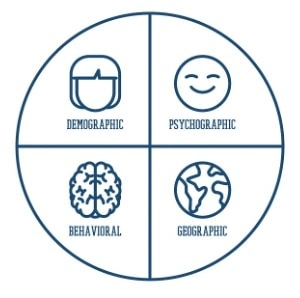It’s all very well saying that your product or service is for everyone, but we should probably be honest with ourselves, as that’s often not the case. It’s imperative that you define your audience, or you could face wasting a lot of cash putting your marketing material in front of people who are simply not interested.
In this article, we’re going to go through a simple process to show you how marketing segmentation is used to identify: where your target market is located, who they are, why they would be interested in buying from you and how to identify factors that influence their purchasing decision.
We will look at the impact of refining your target market for a Facebook Ad campaign using a fictitious upmarket pizza restaurant that wants to provide a delivery service. The restaurant is based in downtown Milton Keynes and is located on a strip that is very popular with people on a night out.

There are four main criteria to address within marketing segmentation: geographic, demographic, psychographic and behavioural; to help us answer our where, who, why, and how questions regarding our target market.
Geographic Segmentation
The easiest criteria to get started with is the geographic segmentation. Here we simply want to determine where your target audience is located. Start by asking yourself: “are they local, regional, national or international?”
Dig a little deeper. If local, is it a particular street, postcode area or district? A specific housing estate, block of flats, borough? Are there areas that you don’t want to include?

Normally our pizza restaurant attracts people who live within the city as well as people who travel from the surrounding area. Add to this people who frequent the city on a regular basis, including commuters and tourists and straight away we have a fairly large geographic area. For our delivery service however, the pizzas can only be delivered to people within a ten minute drive assuming our customer wants the food to still be hot on arrival!
There aren’t any areas that we want to exclude, nor are there areas we are not permitted to deliver to, so for now we’ve narrowed down our geographic area to a simple 2 mile radius of our restaurant.
Demographic Segmentation
Demographic data determines who your audience is by considering: their gender, relationship status, current employment status, and income.

From the data we have already collected from our existing clients, we know there is a relatively even gender split of 48% male and 52% female customers. We also know that 90% of our existing customers fit into the 25-45 age bracket.
Our pizzas are made with the finest fresh, locally-sourced, organic ingredients, combined with imported Italian meats and assorted European cheeses – meaning that we charge a bit more than your average pizza. To assist us here in applying the correct limitations, let’s conduct some research.

Government data from 2018, shows that graduates earned £10,000 per year more than those without a degree*. We can draw from this that there is a high likelihood that graduates are going to have more ‘disposable income’, so targeting people who have a degree or higher is one way we can narrow down our demographic. This may seem very discriminatory, but we are taking a purely data-driven approach.
We can now infer that an employed 32 year old graduate is more likely to order a pizza than an unemployed person over the age of 65. The male to female ratio is very evenly matched, so for this scenario we are going to target both. If we did want to target gender then we could create different ad copy and artwork for the advertisements that better resonate with each gender. For the purposes of advertising, current tools from Google and Facebook only recognise two genders.
Psychographic Segmentation
Psychographic segmentation defines your potential target’s personality, identifies their values, interests, personality traits and other aspects of their lifestyle which help you understand why these kinds of people are your ideal prospective customers.

Psychographic data can be gathered from existing customers by conducting your own market research. For face to face customers this can be done by asking them where they have been, what their holiday plans are, what movies they like and dislike, as well as their hobbies and interests. If your business is solely online, conduct a survey, or schedule an in depth interview with some core customers.
As our restaurant is fictitious, let’s simplify things and use common assumptions. We know that our existing customers like to go out to eat, but let’s see what else we can ascertain about them. We know that they like restaurants, particularly ones that sell Italian food and more specifically – pizza.
Our restaurant is also next to a theatre, and we know that many of our guests have a meal before heading there for a night of entertainment.
Understanding your psychographic segmentation is as much about understanding what traits your ideal customer does have, but also excluding factors that don’t fit our psychographic profile. For example, people who are currently dieting are less likely to order a high calorie pizza for their dinner. Vegans don’t eat meat or cheese, so we could deduce that only a small percentage of our menu will be suitable for them, meaning they don’t fit into our ‘ideal customer’. This does however create a separate target market we could promote our delicious marinara pizzas to – particularly in Veganuary.
Behavioural Segmentation
This market segment is the most overlooked. It’s more difficult to gather behavioural information but is vitally important to understand how a person goes through their decision making and buying process. It will help us work out if a customer is ready to commit to a purchase, and what signals they give off from their activities to signify this.

Fortunately, Google Analytics can provide us with excellent data regarding the acquisition (social, paid, organic, direct or referral), the percentage of return website visitors versus new customers, the number of pages they visit, time spent looking at your website, and which device and operating system they are using, to name a few. Each of these variables can help you tailor your marketing collateral to niche audiences who are at different stages of their customer journey.
At our fictitious pizza shop we have gathered data from a number of online food ordering platforms we manage, and the majority of these show that they acquire more than half of their online orders through social media channels. We can trace this back further and see that a large majority, over 60%, are coming from Facebook. We can assume that these people are comfortable buying or ordering goods online, and / or have explicitly expressed the desire to do so.
For the purpose of this exercise we will say that, in addition to the three previous segments, this is sufficient to qualify them as a potential customer.